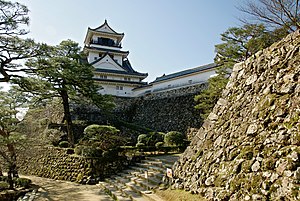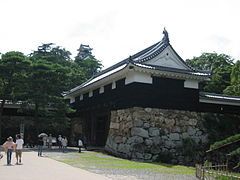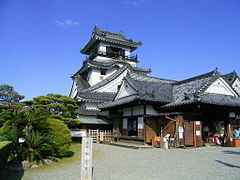Kochi Castle
| Kōchi-jō | ||
|---|---|---|
|
Kochi Castle |
||
| Creation time : | 1601 | |
| Castle type : | Hirayamajiro (hill castle) | |
| Conservation status: | Partly preserved | |
| Place: | Kochi | |
| Geographical location | 33 ° 33 '40 " N , 133 ° 31' 53" E | |
|
|
||
The Kōchi Castle , ( Japanese 高 知 城 , Kōchi-jō ), is a castle in the city of Kōchi , Kōchi Prefecture in Japan . It had been the seat of the Yamanouchi since 1601 , who belonged to the great Tozama daimyo of the Edo period .
history
At the end of the 16th century, Chōsokabe Motochika ( 長 宗 我 部 元 親 ; 1539-1599) was lord of Shikoku until Toyotomi Hideyoshi restricted him to the province of Tosa . Motochika planned to build a castle on the 42 m high mountain Ōtakaki-yama ( 大 高 坂 山 ) and a castle town below it. But since the area was too swampy, he set about building a castle on Urato Bay ( 浦 戸 湾 , Urato-wan ). At the Battle of Sekigahara in 1600, however, the Chōsokabe were among the losers and lost their property.
Now Yamanouchi Kazutoyo ( 山 内 一 豊 , 1545–1605), coming from Kakegawa Castle ( Ōmi Province ), received this province with an income of 240,000 koku. Urato Castle was too small for him and could not be expanded, so he returned to Ōtakaki as a location. In 1603 he was able to move into the new castle there. When in 1610 water damage in the city below the castle was to be lamented, the castle hill - and with it the whole place accordingly - was renamed "Kōchiyama" ( 高 知 山 ).
The attachment
The castle is large with an extension of about 300 m in east-west and north-south directions. The upper areas are protected by stone walls, the outer area by a surrounding moat and earth walls. The innermost area, the Hommaru, lies in the south, while the Ni-no-maru protects in the north, which is connected to the Hommaru by a bridge over a dry moat. Both areas are surrounded by the San-no-maru.
In 1727 fires from the lower town reached the castle, which burned down almost to the Oite gate ( 追 手 門 , Oite-mon ). It was then rebuilt from 1729 to 1753. The castle tower that was rebuilt in the process was recreated from the tower originally built by Kazutoyo, as revealed during a dismantling and repairing process carried out in recent years. In 1871 the castle was largely demolished, the castle grounds became a public park and it is known for its cherry blossom. In 1934 the castle was registered as a historical heritage. The castle was completely restored from 1948 to 1959.
Most of the castle's buildings have disappeared, but the castle tower, the small residence in Hommaru - also called Kaitokukan ( 懐 徳 館 ) here -, the Nando granary (納 戸 蔵, Nando-kura), the Kurogane gate (黒 鉄 門, Kurogane-mon), the Western Bastion Building (西 多 聞 櫓, Nishi-tamonyagura), the Eastern Bastion Building ( 東 多 聞 櫓 , Higashi-tamonyagura ), the Tsume Gate ( 詰 門 , Tsume-mon ) and the Rōka- Gate ( 廊下 門 , Rōka-mon ), the Oite Gate, stone walls and earth walls. Memorial stones and sculptures can also be seen, including the famous Kazutoyos horse.
photos
Remarks
- ↑ One of the twelve preserved castle towers ( 天 守 閣 , Tenshukaku ) from the Edo period.
- ↑ There was another residence at the foot of the castle.
- ↑ The two gates protected the covered transition between Hommaru and Ni-no-maru.
literature
- Ikeda, Koichi .: Kochi-jo in: Miura, Masayuki (Ed.): Shiro to jinya. Saikoku-hen. Gakken, 2006. ISBN 978-4-05-604379-2 .
- Nishigaya, Yasuhiro (Ed.): Kochi-jo. In: Nihon meijo zukan, Rikogaku-sha, 1993. ISBN 4-8445-3017-8 .








